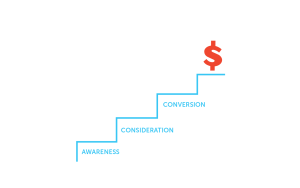Before you know it, we’ll be in 2022. In preparation for the new year, it’s time to put together your marketing goals! Having trouble setting up the right goals for your team? Maybe you don’t know where to start? Look to SMART goals to turn your marketing plan into something both quantifiable and achievable.
What Are SMART Goals?
Research has shown that marketers who set goals are 376% more likely to report success than those who don’t. And 70% of those successful, goal-setting marketers achieve them. You can make sure you’re setting SMART goals by ensuring that each goal has these five attributes:
- Specific
- Measurable
- Attainable
- Relevant
- Time-Bound
Specific
Let’s say you have a goal of increasing the traffic to your blog pages. Increasing blog traffic is a nice goal, but it isn’t specific enough. How are you planning to increase blog traffic? What exactly are you aiming for? A more specific goal may be as follows:
Increase blog traffic by adding a category of Employee Engagement to the blog.
Measurable
How will you know when you get there? A key to setting SMART goals is making them quantifiable. Do you want to increase traffic by 5%, 25%, or 50%? Setting a measurable goal helps you get actual results because you know what you’re working towards.
Increase blog traffic 25% by adding a category of Employee Engagement to the blog and assessing its efficacy on a monthly basis.
Attainable
Don’t set yourself up for failure. Once you achieve a goal, you can raise the bar. If the goal isn’t achievable, it’s not a goal; it’s a dream. Increasing blog traffic by 25% may be unrealistic if your current monthly increase is less than 2%. When setting up your goal – make it make sense!
Increase blog traffic 25% by posting two to three articles per week in a new category of Employee Engagement and assessing its efficacy on a monthly basis.
Relevant
Marketing goals must have a purpose while keeping that goal in mind. Why are you looking to increase blog traffic? Are you trying to improve your inbound marketing strategy? Do you need better lead generation? When setting SMART goals, begin with the end in mind.
Increase blog traffic 25% by posting two to three articles per week in a new category of Employee Engagement and assessing its efficacy on a monthly basis, making adjustments as needed.
Timely
The goal may be to increase traffic by 25% by the end of 2022, but setting a quarterly goal of 5% may be a better option, as it allows you to adjust tactics if you need to and set benchmarks to achieve that goal. If you want to set SMART goals, be sure to evaluate and revise your progress at set intervals throughout the year.
A Smarter Goal
Remember that goal we started out with? “Increase blog traffic?” Here’s how it looks now:
Increase blog traffic (Relevant) by 25% (Measurable) in 2022 (Timely) by posting two to three articles per week (Attainable) in a new category of Employee Engagement (Specific) and assessing its efficacy on a monthly basis, making adjustments as needed.
Now that you have goals, how can you practice setting SMART goals and create an outstanding marketing plan?
How to Use SMART Goals
Marketing goals are not created in a vacuum. Every goal should play a part in the company’s overarching goals. So how do you ensure that your marketing goals are in tune with your company’s goals?
Identify Business Objectives
Business objectives can be long-term, such as “Become an industry leader by 2028,” or short-term, such as “increase revenue in 2022 by 15%.” It may be best to formulate both short- and long-term goals, thereby giving yourself a larger achievement to strive towards while simultaneously making progress through other, smaller achievements. Be mindful of the timeframe and scale of goals you are setting, and distinguish which ones you believe can be accomplished in the short-term versus the long-term.
Ready to Add Digital Marketing Services To Your 2022 Marketing Plan?
Set Priorities
A marketing strategy needs to address all business objectives, but time and budget constraints may make it impossible to address objectives equally – or at the same time. It is essential to set priorities so that you know where to focus your resources.
With prioritized business objectives defined, you are ready to put together your annual marketing plan. Setting SMART goals can make writing that plan a little easier. For example, consider the goal of increasing blog traffic (which is now a fully formed SMART goal). What changes should you make to align it with a goal of a 15% increase in revenue?
Related: 5 Beginner Tips for Digital Marketing Newbies
Align Goals
Aligning goals means taking a thoughtful look at your business and marketing goals. If the company needs to increase revenue, you need to ask yourself questions about your blogging goal, such as:
- What percentage of website visitors currently convert into buyers?
- If you have a 20% conversion rate, how many visitors are needed to increase revenue by 15%?
- Do you need to look at more than increased blog traffic?
- Do you have the budget to hire content writers or hire someone full time?
- How many times do we need to strategically schedule blog posts to meet our SMART goal?
By answering these questions and connecting them to SMART goals, you’ll see your marketing plan take shape. Maybe you could drive more traffic with a downloadable eBook instead of more blog posts. Instead of using resources to hire writers, you might try a print campaign. When your marketing and business goals align, developing a plan that supports company-wide objectives is much easier. Setting SMART goals now will help you take on your marketing challenges throughout the year, and Ironmark can help you even further. You can also get in touch with us for help on everything related to your marketing needs – we’re always here to help!




